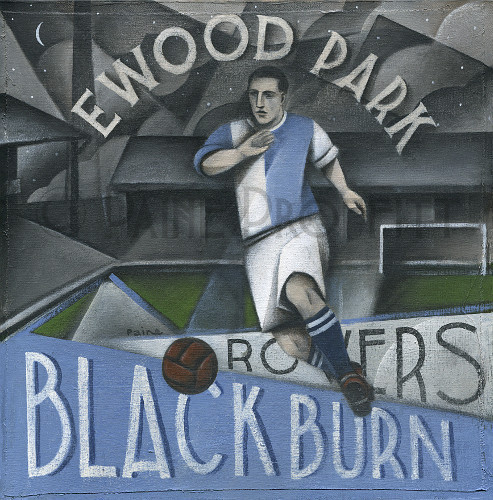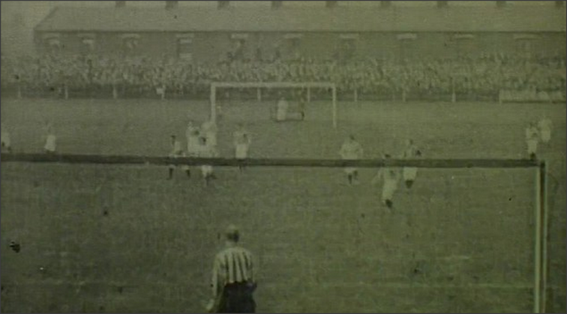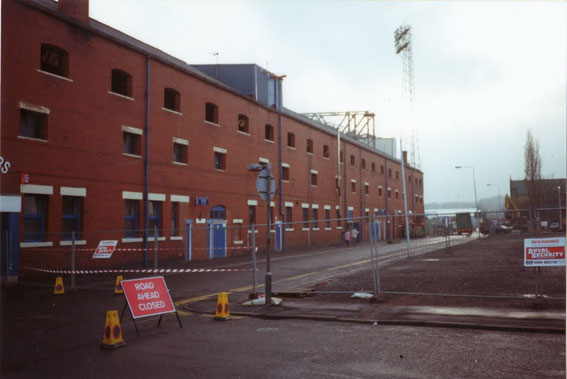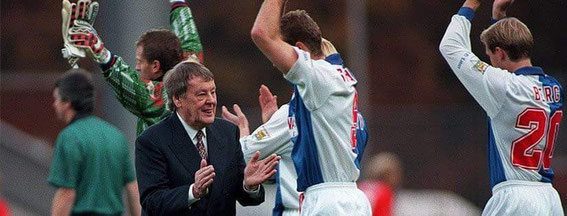Ewood Park: The Cradle of English Football
Chronology of Events
Football Association established: 1863.
Laws of the game: Approved by the Football Association : 1863.
Notts County F.C. established: 1863.
Laws of the game: Forward passes are permitted, as long as there are three defending players between the receiver and the goal: 1866
Laws of the game: Introduction of the specific position of goalkeeper: 1871.
Football Association Cup established: 1871.
Blackburn Rovers F.C. established: 1875.
Laws of the game: Full unity with the Sheffield Rules is established – several features of the northern code had been incorporated into the London-based
association rulebook over the preceding 14 years: 1877.
Blackburn Olympic F.C. established: 1878.
Preston North End F.C. established: 1880.
Blackburn Olympic F.C. win the Football Association Cup: 1883.
Blackburn Rovers F.C. win the Football Association Cup: 1884.
Blackburn Rovers F.C. win the Football Association Cup: 1885.
Football Association legalises professionalism: 1885.
Blackburn Rovers win the Football Association Cup: 1886.
Football League established: 1888.
Preston North End win the Football League: 1888-89.
Preston North End win the Football League: 1889-90.
Blackburn Olympic folded: 1889.
Laws of the game: The penalty kick is introduced: 1891.
Football League Division 2 established: 1892.
Football League Division 3 (South) established: 1920-1921.
Football League Division 3 (North) established: 1921.
Laws of the game: The offside rule is reduced from three to two defending players between the player and the opponent's goal line: 1925.
Laws of the game: Introduction of substitutes: 1958.
Football League Division 3 established: 1958.
Football League Division 4 established: 1958.
Football League Cup established: 1960
Laws of the game: Introduction of red and yellow cards: 1970.
Laws of the game: Introduction of the back-pass rule: 1992.
Football Association Premier League established: 1992.
Blackburn Rovers win the Premier League and crowned Champions of England: 1995.
Ewood Park officially reopened: 1995.
Laws of the game: Goal-line technology is permitted, if the individual competition wishes to implement it: 2012.
Blackburn Rovers are one of only three clubs to have been both a founder member of the Football League and the Premier League; the others being fellow Lancastrian's Everton and Warwickshire club Aston Vila.
Blackburn Rovers are the only Football Club to be founder members of the Premier League and Football League and Champions of both.
During the 1880's, the dominance of the upper-class southern public school, army and university teams came to an end as the game took root in the industrial heartlands of Lancashire and the west and north Midlands.
Even though clubs like Blackburn Rovers were formed by middle-class grammar school boys, with the participation of the working-class, both as players and spectators, the game eventually ceased to be the exclusive pursuit of the genteel middle and upper-classes and became a mass spectator sport.
Even before professionalism was legalized in 1885 and certainly after the legalization of professionalism, these new breed of clubs were building enclosed grounds; charging admission fees and being run for profit.
Intense competition led to players being poached by one club from another and financial inducements, forbidden by the FA's strict rules on amateurism, became commonplace.
Before professionalism and the Football League was created, it was the FA Cup that was competed for by teams from both England and Scotland. The FA Cup went north for the first time to the unknown working-class team of Blackburn Olympic rather than the former grammar school boys of Blackburn Rovers. Olympic won the cup and Olympic's victory marked a turning point in the sport's transition from a pastime for upper-class gentlemen to a full time professional sport enabling the participation of working-class men.
The more middle-class club of Blackburn Rovers thrived, poaching eight of Blackburn Olympics players before going on to
achieve FA Cup dominance and becoming the first glamour club of the English game with three successive FA Cup triumphs in 1884, 1885 and 1886; the year before, during and after the legalisation
of professionalism.
As a result of The Football Association bowing to pressure from clubs like Blackburn Rovers and Aston Villa and because of the heroic success of Blackburn Olympic, The Football Association recognised professionalism and the balance of power shifted decisively north - no amateur side has appeared in the final since then.
Ewood Park is also one of the oldest homes to an English football club.
Blackburn Rovers, founded in 1875, are one of the oldest professional football clubs in the world, although Rovers did not take up permanent residence at Ewood Park until 1890, they began playing games at Ewood Park in 1882.
Bramall Lane, the home of Sheffield United Football Club is the oldest major stadium in the world still to be
hosting professional football matches, however, it was not until 1889 the year that Sheffield United were formed that it became the home of Sheffield United.
Although Blackburn Rovers were formed in 1875, Ewood Park did not become the permanant home of Blackburn Rovers until 1890, the year after Sheffield United moved into Bramall Lane, though as already mentioned, Rovers began playing at Ewood Park in 1882, a full seven years before Sheffield United were formed.
However, after having seen the sporting and financial success of Blackburn Olympic and particularly Blackburn Rovers in East Lancashire, Preton North End finally adopted Association football in 1880 and played their first game at Deepdale in that same year after first trying cricket in 1863 and then Rugby Union in 1875.
Preston North End also became the first Football League Champions in 1888-89 and 1889-90.
So why is Ewood Park the Cradle of English Football when we consider that the oldest football ground in Britain and in the whole world is at Sandygate, another ground in Sheffield?
These things are subtle and nunanced and there are many different ways of looking at them.
For example, Sandygate first opened in 1804 and is recorded in the Guinness Book of Records as the oldest football ground in the world; also, in 1862 Notts County F.C. was established and is the oldest football club in the world and the English Football League; in 1863 Stoke City F.C. was established and is the oldest football club in the English Premier League.
So are we talking about amateur clubs? Professional clubs? None League clubs? Football League clubs? Premier League cubs?
It depends and I don't think there is any right or wrong. However, I believe that football would never have professionalised and the game would never have transitioned from a genteel pastime for the idle upper-class and nurtured into what became a mass spectator and participent working-class sport if it were not for the success of Blackburn Rovers and Blackburn Olympic and all of these achievements by Blackburn Rovers and Blackburn Olympic were before the Football League was established.
1) Brammall Lane (Sheffield United, England) built: 1855
2) Deepdale (Preston, England) built: 1875
3) Ewood Park (Blackburn Rovers, England) built: 1882
1) Preston North End played at Deepale: 1880
2) Blackburn Rovers played at Ewood Park: 1882/1890
3) Sheffield United played at Brammall Lane: 1889
Blackburn Olympic win the FA Cup: 1883
Blackurn Rovers win the FA Cup: 1884, 1885, 1886.
Football is now a mass working-class spectator and participant sport.
Premier League Champions: 1995 making Blackburn Rovrers the only Founder Members of the Football League and Premier League and Champions of both.
Blackburn Rovers and West Bromwich Albion feature in oldest footage of a football match dating from 1898 at Ewood Park, Blackburn.
-
The 45-second clip shows a passage of play from the Blackburn Rovers vs West Bromwich Albion match at Ewood Park on September 24, 1898.
-
It is the the oldest film clip of a football match in existence.
-
The footage was discovered in the North West Film Archive.
-
12,000 fans were present that day as Blackburn won 4-1.
-
It was captured by film pioneer Arthur Cheetham.
-
The greatest Rovers of them all, Bob Crompton, also played in this match.
Link to video footage:
http://www.dailymail.co.uk/sport/football/article-2877268/Blackburn-West-Brom-feature-oldest-footage-football-match-dating-1898.html#v-3947345427001
Screenshots below show passages of play from Blackburn Rovers v West Bromwich Albion at Ewood Park, 1898.

Blackburn Rovers In Training, Ewood Park, 1929.
Blackburn Rovers In Training, Ewood Park, 1934.
Ewood Park, 1979. The ground had changed little since the 1920's and remained unchanged until the ground was completely redeveloped between 1992-1995.
Official Opening of the redeveloped Ewood Park took place: 18/11/1995. Rovers beat Forrest 7 - 0 to celebrate.
Blackburn Rovers 7 v 0 Nottingham Forrest.

Other goal scorers for Rovers were Newell 82 and Le Saux 89 min's.
Famous football stadiums designed by architect, Archibald Leitch.
Ewood Park, 19th October 1928.

Look closely and it is possible to see what appear to be Crofts on the hillside to the left of The Riverside stand. Is this were the Higher Croft estate (which has produced a numbers of Rovers' terrace legends) gets its name from?
Ewood Park late 1990's.
So when did the Rovers come to Ewood and how did Ewood Park come to Ewood?
The land that Ewood Park was built on was originally used for drying cloth dyed at Ewood print works and later as pasture land for cattle. In November 1881
four Blackburn business men acquired 14 acres of this land from Edward Petre (once Lords of the Manor of Rishton) for £5000. The area was enclosed by a large wooden fence, drained and
re-turfed, a half a mile by 35ft race track was laid out and also a straight track measuring four hundred yards by 28 feet was laid down.
The Blackburn Standard of April 15 says:
“Horse boxes, dressing tents, a refreshment saloon, lavatories, etc., will be erected in a short time…A large and comfortable grand stand, with a natural elevation, will also be built and comfortable vantage ground will be afforded to all who attend the sports. The ground contains some pure spring water, and it is thought that if the sports prove successful probably baths will be built for the summer months. A platform for dancing will also be constructed, and the gentlemen who have purchased the ground are determined to do all they can for the comfort of the working classes, and offer them (every) possible facilities for enjoying themselves.”
The stadium was opened on the 8th of April 1882. The total cost of the building work was estimated at being £9,000.
On the opening day, the Blackburn Times said:
“The weather was most favourable, though other attractions in the town influenced the attendance of spectators. However, there were 1,000 present, and considerable interest was manifested in the different events.”
The first events held were the heats of a 200 yards “dog handicap,” with a first prize of £20, second, £7, third £3. There then followed the heats for a
200 yards “foot handicap race”, the first prize being £20 and three other prizes of £5, £3 and £2, there were 21 competitors entered into the foot race.
The competition continued on Monday afternoon when 3,000 spectators turned up to watch the concluding rounds of the dog race and the foot race.
The winner of the dog race was “Cur” belonging to a Mr. Hopkinson from Tottington, and the winner of the foot race was W. Cummins of Preston.
Later in the afternoon a wrestling match took place for £20 between Alfred Aspen of Guide and John Clegg of Oswaldtwistle with Clegg coming out the winner.
In the following years Ewood Park was used for all kind of events including athletics, dog racing, trotting racing, and cycle racing, at one point it boasted one of
the biggest and fastest cinder cycle tracks in the north. The Blackburn Michaelmas Fair was held there from October 9th to 19th 1885.
In 1890 the ground was taken on a ten year lease by the Blackburn Rovers Committee and the Rovers played their first match at Ewood Park against Accrington in
front of a crowd of 10,000, the result being a 0-0 draw. Even though the Rovers had leased Ewood Park other events were still held there, such as the athletics festival of July
1891.
In 1893 it was decided by the Committee that they should buy the ground, and on Wednesday 24th January 1894 the papers reported:
“PURCHASE OF EWOOD PARK BY THE BLACKBURN ROVERS”
“Last evening the committee of the Blackburn Rovers Football Club completed the purchase out and out of Ewood Park, their famous enclosure. The club had already spent £3,000 on the ground, and they now propose to erect on the south side of the ground, where twenty additional yards of land have been purchased, a huge covered stand, which will make the ground the largest in England, and accommodation equal to nearly forty thousand spectators. The purchase money amounted to £2,000.”
On New Year’s Day 1896 the Rovers faced Everton at Ewood Park. During the game a part of the stand on the north end of the ground collapsed injuring about twelve people, a section of the crowd climbed over the rails on to the field. After the police had restored order the game continued with Everton coming out on top winning 3-2.
The Blackburn Times was the only local paper to report the accident but could only find room for a sentence. After a lengthy report on the match they finished
with:
“The collapse of the stand also affected the Rovers play, coming as it did when they were pressing.”
However The Leeds Mercury Thursday January 2nd 1896 gave a fuller account:
”COLLAPSE OF A STAND AT A FOOTBALL MATCH”
“Towards the end of the football match between the Blackburn Rovers and Everton, at Blackburn, yesterday, an open stand, on which were two thousand people, suddenly collapsed in the centre. For the moment a panic ensued among the spectators but the police were quickly on the spot and order was soon restored. Fortunately, not more than a dozen people were injured, and only three at all seriously. These were carried on to the ground and attended to.”
Text was provided by Blackburn with Darwen Borough Council for use in the Cotton Town digitisation project: www.cottontown.org.

Again it is possible to see what looks like a Crofters cottage on the hillside to the left of The Riverside stand while below we can see atop the hill, Higher Croft estate.
 Ewood Park
The Cradle of
English Football
Ewood Park
The Cradle of
English Football
































